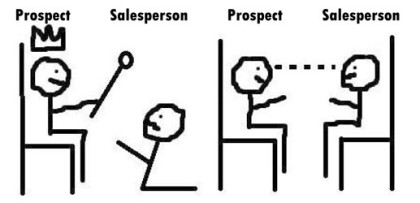Over the past few months, we have discussed the seven steps of a professional selling process. In particular, the process we discussed is the Sandler Selling System. Understand that Sandler is not the only selling system out there in the market. In fact, there are other very good selling systems you can learn and use. Yes, I believe Sandler is the best system, but you would be far ahead if you made the decision to embrace any good selling system, practiced it, got good at it, and used it with discipline every time the sales dance begins. And herein lies a big challenge that must be discussed.
Even though you now use a selling system, your prospect will still try to lead the dance down the path of their buyer’s system. At Sandler, we call this moment in the sales dance “Wimp Junction.” The prospect will undoubtedly ask you to dump your intellectual property early, request a proposal, ask for a product demo, or get the salesperson to do any kind of work without any commitments, agreements, contracts, or purchase orders and if you, the professional salesperson, comply to the request you have just agreed to move forward with the buyer’s system and failed in Wimp Junction. In so doing, you have left the professional selling system on the shelf where it can bring zero value to you.
If I were to diagram the buyer’s system vs. a professional system, this is what I would draw:
Buyers will naturally, subconsciously take on the posture of being one-up to you, the salesperson. The salesperson then finds themselves in a one-down position relative to buyer. Prospects get away with this most times because the majority of salespeople let them. This is represented by the drawing on the left, the Buyer’s System. It’s kind of like when a parent asks a child to go do something and the child obeys because the parent has the position of authority (one-up) and the child has the position of submission (one-down). Even if the salesperson goes into a call with a plan to lead the dance, the prospect will still assert the one-up position and that’s okay. You as the sales professional just need to recognize it and push back when it happens, asserting a professional posture which is represented by the picture on the right, the Professional System. The prospect may try to go one-up multiple times in a single sales dance, which puts you into Wimp Junction repeatedly, and each time it happens you must hold your ground and bring the dance back into the professional system. Here is an example:
Failure at Wimp Junction
Prospect: “So, how can your solution help my business?”
Salesperson: “Well let me tell you what I can do. We can do . . . . “
Success at Wimp Junction
Prospect: “So, how can your solution help my business?”
Salesperson: “I am not sure it can. Could you tell me about the challenges you are facing?”
In the first exchange, the prospect puts the salesperson in Wimp Junction by asking a simple question. The salesperson submits and fails in Wimp Junction because the intellectual property which is highly valuable to the prospect is offered up without any commitments. In the second exchange, again the prospect puts the salesperson in Wimp Junction, but this time, the salesperson holds on to what is valuable and shifts the focus back to the prospect, thus keeping the sales call in the professional system. For greater success in sales, beware of Wimp Junction and always keep it professional. Sandler Training can help you stay professional.
by Karl Schaphorst, President
402-403-4334 | www.karlschaphorst.sandler.com
Sandler Training is a global training organization with over three decades of experience and proven results. Sandler provides sales and management training and consulting services for small- to medium-sized businesses (SMBs) as well as corporate training for Fortune 1000 companies. For more information, please contact Karl Schaphorst at (402) 403-4334 or by email at kschaphorst@sandler.com. You can also follow his blog at karlschaphorst.sandler.com


